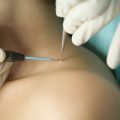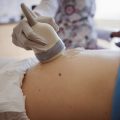How does this happen
 A photo: Getty ImagesThe process of lactation begins long before delivery. The female breast prepares to feed the child gradually: it grows due to the growth of glandular tissues, forming lobules and ducts. When squeezing the nipples, milk-like liquid is released. It is not necessary to prepare yourself specially for feeding (pulling nipples, wearing nozzles). The shape and size of the nipples do not affect the lactation process or the sucking process. Women with both flat and retracted nipples can successfully breast-feed their children. How soon after delivery should the child be fed? Some experts advise putting the children to the breast not earlier than four to six hours after the birth, other doctors recommend that all children be applied to the breast immediately after childbirth. There is evidence that mothers who put children to their breasts in the first two hours after they were born are supported longer. But it is not proven that the baby should be fed immediately after childbirth. In addition, such feeding often involves a number of difficulties. First, a woman may need a rest. Secondly, the first contact and especially the first feeding require certain conditions - a comfortable environment in which the mother can enjoy communication with her baby. Third, many women, especially primiparas, do not know how to properly hold the baby and put it to the chest, because the posture of the child and the mother contributes a lot to the success of feeding. Some inexperienced mothers try to correct the chest, pull the nipple out of the child's mouth, then break the feeding. As a result, the child is nervous, captures the nipple with the areola in a hurry, improperly, causes pain to the mother, begins to cry.
A photo: Getty ImagesThe process of lactation begins long before delivery. The female breast prepares to feed the child gradually: it grows due to the growth of glandular tissues, forming lobules and ducts. When squeezing the nipples, milk-like liquid is released. It is not necessary to prepare yourself specially for feeding (pulling nipples, wearing nozzles). The shape and size of the nipples do not affect the lactation process or the sucking process. Women with both flat and retracted nipples can successfully breast-feed their children. How soon after delivery should the child be fed? Some experts advise putting the children to the breast not earlier than four to six hours after the birth, other doctors recommend that all children be applied to the breast immediately after childbirth. There is evidence that mothers who put children to their breasts in the first two hours after they were born are supported longer. But it is not proven that the baby should be fed immediately after childbirth. In addition, such feeding often involves a number of difficulties. First, a woman may need a rest. Secondly, the first contact and especially the first feeding require certain conditions - a comfortable environment in which the mother can enjoy communication with her baby. Third, many women, especially primiparas, do not know how to properly hold the baby and put it to the chest, because the posture of the child and the mother contributes a lot to the success of feeding. Some inexperienced mothers try to correct the chest, pull the nipple out of the child's mouth, then break the feeding. As a result, the child is nervous, captures the nipple with the areola in a hurry, improperly, causes pain to the mother, begins to cry. Photo: publishing house "Exmo"
Photo: publishing house "Exmo"
The syndrome of a firm breast
On the third day after birth, sometimes earlier orLater, the breasts increase in size, fill with milk, become denser, more painful, and a feeling of heaviness arises. Some women are overcome by panic: they put the baby to the breast, the baby cannot suck productively, he cries, more milk comes, the breasts are bursting, severe pain appears - a vicious circle is created. Why do breasts harden? The lobules (alveoli) of the mammary glands produce a certain amount of milk, which accumulates in them, as well as in the ducts. And if you do not get rid of the milk, then its excess will stretch the lobules and partially damage them, which in turn will cause an influx of more blood with the substances necessary for "repair" - additional swelling of the adjacent tissues occurs. Unpleasant sensations and pain appear. If you do not ensure timely outflow of milk, a blockage of the duct may occur or an infection will develop. The less milk outflow, the less it is produced - lactation is suppressed. Cold or hot compresses, oxytocin injections, using a breast pump and other methods of dealing with hardening are ineffective. A photo: Getty Images Nothing like this will help you cope with any hardening in your chest caused by the obstruction of the ducts and the accumulation of milk, like feeding your baby. Only the ducts adjacent to the nipple can be released by decanting, but no deeper ducts and lobules accumulating milk. If the breast is firm, then it should be massaged a little before feeding. Hand movements should not be sharp, squeezing, hurting. Simple stroking of the breast will bring more benefits than rough unprofessional massage. It is necessary to take into account that the outflow of milk goes from the lobules along the ducts to the nipple (from the periphery to the center). Therefore chaotic movements, directed in different directions or starting from the nipple, can worsen the situation. Massage-stroking should not be long, as any touch to the chest, including the nipples, causes a reflex reaction - the allocation of milk.
A photo: Getty Images Nothing like this will help you cope with any hardening in your chest caused by the obstruction of the ducts and the accumulation of milk, like feeding your baby. Only the ducts adjacent to the nipple can be released by decanting, but no deeper ducts and lobules accumulating milk. If the breast is firm, then it should be massaged a little before feeding. Hand movements should not be sharp, squeezing, hurting. Simple stroking of the breast will bring more benefits than rough unprofessional massage. It is necessary to take into account that the outflow of milk goes from the lobules along the ducts to the nipple (from the periphery to the center). Therefore chaotic movements, directed in different directions or starting from the nipple, can worsen the situation. Massage-stroking should not be long, as any touch to the chest, including the nipples, causes a reflex reaction - the allocation of milk.









